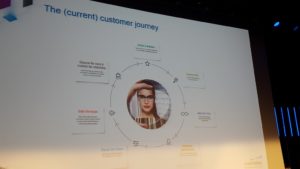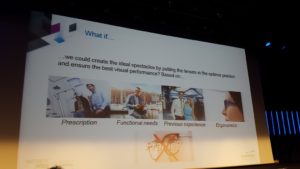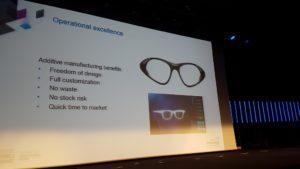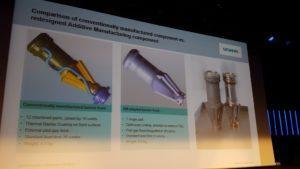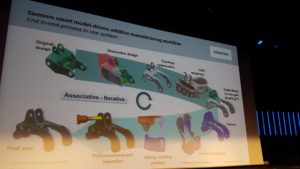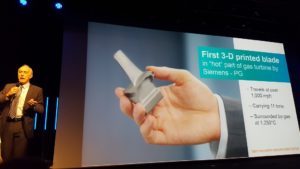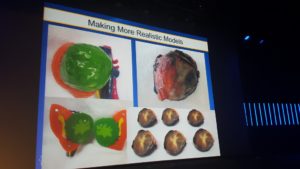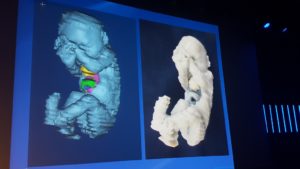 As Materialise World Summit 2017 truly gets underway, participants and attendees are sharing knowledge and focusing on real-world applications for the latest in technology. This morning, the event kicked off with a keynote session; we’ve heard from Materialise CEO Fried Vancraen and Belgium’s Deputy Prime Minister Alexander De Croo. Rounding out the impressive morning were presentations from Yuniku, Siemens, and the Mayo Clinic as we took a global perspective across several industries and applications for additive manufacturing.
As Materialise World Summit 2017 truly gets underway, participants and attendees are sharing knowledge and focusing on real-world applications for the latest in technology. This morning, the event kicked off with a keynote session; we’ve heard from Materialise CEO Fried Vancraen and Belgium’s Deputy Prime Minister Alexander De Croo. Rounding out the impressive morning were presentations from Yuniku, Siemens, and the Mayo Clinic as we took a global perspective across several industries and applications for additive manufacturing.
Speaking to the application of 3D printing technology in the increasingly customizable eyewear industry, Félix S. España of HOYA Vision Care and Dr. Ir. Alireza Parandian, Corporate Innovations Manager, Materialise discussed transformative innovation. Work in eyewear has been in focus for Materialise as an example of what is possible with a focus on co-creation as companies come together to share resources and build a customer-centric business.
España spoke to several key pillars of work here, including product innovation, business model, operational innovation, and customer experience. It was notable that in his presentation the last concept to be addressed was company profitability; of course this is always an area of concern for any company, but for real innovation in a customer-facing operation, it cannot take the front seat in focus. Customer experience underlies operations, and building a loyal base is important to sustaining business operations. For its part, HOYA presents “a journey about innovation,” and was the first company in eyewear to utilize augmented reality in stores, and with Materialise co-created the first virtual reality headset to give consumers the possibility to validate their visions. This all starts by asking: what if?
“What if… we could create the ideal spectacles by putting the lenses in the optimal position and ensure the best visual performance? Based on… prescription, functional needs, previous experience, ergonomics – not on frame.”
 Around two years ago, the co-creation journey began, through which HOYA and Materialise could:
Around two years ago, the co-creation journey began, through which HOYA and Materialise could:
- Identify product requirements
- Turn requirements into concepts
- Put concepts through testing
España explained that “there’s no technology like 3D printing to bring this product to market.” Benefits of including additive manufacturing include:
- Freedom of design
- Full customization
- No waste
- No stock risk
- Quick time to market
Whenever the design is approved, he explained, it can be available in 3,000 stores in 24 hours. The business model in play here allows for benefits for eyewear professionals ranging from differentiation to quality of service and customer loyalty to, finally, profitability.
 Andreas Saar took to the stage next to discuss developments from Siemens, which has been in the headlines quite frequently lately as the multinational corporation opens up about its uses of additive manufacturing. From highly visible applications including the first full load test of 3D printed gas turbine blades to touching on the more across-the-board applications for Product Lifecycle Management (PLM) software, Saar caught the attention of all those gathered in the hall as he detailed the company’s view, so pervasive it was the title of his keynote: “Additive manufacturing reshapes everything. Reimagine products. Retool manufacturing. Rethink business.”
Andreas Saar took to the stage next to discuss developments from Siemens, which has been in the headlines quite frequently lately as the multinational corporation opens up about its uses of additive manufacturing. From highly visible applications including the first full load test of 3D printed gas turbine blades to touching on the more across-the-board applications for Product Lifecycle Management (PLM) software, Saar caught the attention of all those gathered in the hall as he detailed the company’s view, so pervasive it was the title of his keynote: “Additive manufacturing reshapes everything. Reimagine products. Retool manufacturing. Rethink business.”
“We believe at Siemens that additive manufacturing is a major game changer,” Saar said in what turned out to be the understatement of the morning. “Additive manufacturing — it shapes everything. Let’s reshape the world.”
 Reshaping requires rethinking, which is exactly what Siemens is hoping to do through an increased focus on more advanced technologies. Saar noted that AM in itself “is a major challenge and a major opportunity to rethink everything,” leading to rethinking, innovating, retooling, and changing processes; it is, in short, an “enormous journey.” Discreetly dropping mention of “a competitor of ours with two letters who does more with marketing,” Saar used the opportunity to touch more on Siemens’ uses of additive manufacturing in turbine and other heavy, mission-critical applications.
Reshaping requires rethinking, which is exactly what Siemens is hoping to do through an increased focus on more advanced technologies. Saar noted that AM in itself “is a major challenge and a major opportunity to rethink everything,” leading to rethinking, innovating, retooling, and changing processes; it is, in short, an “enormous journey.” Discreetly dropping mention of “a competitor of ours with two letters who does more with marketing,” Saar used the opportunity to touch more on Siemens’ uses of additive manufacturing in turbine and other heavy, mission-critical applications.
“Additive manufacturing really allows you to innovate faster; time to innovation, time to market is essential,” Saar said. “We’re living today in a fast-changing world. Iterate and innovate at a fast pace.”
AM allows for speeds unheard-of from traditional techniques; the example given noted that a two-year time to market from conventional technologies could be reduced to two months with AM. The four major value streams Siemens points to are:
- Individualization
- Product Optimization
- Manufacturing Efficiency
- Business Models
Of course, limitations exist as well, including:
- Disconnected Software
- Multiple File Conversions
- Uncontrolled Workflow
- Conventional Thinking
 When working with new, unconventional technologies, it is of course important to not be limited by old ways of thinking; what used to work doesn’t fit with what is now possible. (Rethink.) Last week, Siemens and Materialise announced a software integration that is set to have perhaps a bigger impact than many had initially realized. Echoing a sentiment we are hearing more frequently across the industry, Saar said:
When working with new, unconventional technologies, it is of course important to not be limited by old ways of thinking; what used to work doesn’t fit with what is now possible. (Rethink.) Last week, Siemens and Materialise announced a software integration that is set to have perhaps a bigger impact than many had initially realized. Echoing a sentiment we are hearing more frequently across the industry, Saar said:
“We believe partnerships are important, this is the only way to drive this technology forward.” He continued, “Materialise has proved that this works; we integrate seamlessly without data interface changes… We announced this last week, it is the first product on the market, we believe there is much more to come.”
Siemens is working as well with companies like Trumpf and HP on the hardware side, and Saar noted that the company “will continue to expand with our partners.” Co-creation and innovation comes into play for Siemens throughout their business operations as related to AM.
While Saar presented some big ideas covering aerospace and business operations, the morning’s closing keynote turned to look inward — literally. Medical 3D printing applications ranging from medical models to patient-specific surgical tools to 3D printed implants and, eventually, bioprinting are being put into practice at the world-leading Mayo Clinic, as Dr. Jonathan (Jay) Morris discussed the past eight years in 3D printing at the hospital.
“Eventually, it had to move beyond one-offs and interesting stories,” Dr. Morris said, touching on how the Mayo Clinic sought to integrate 3D printing technologies into more of its more than 76,000 annual surgical procedures.
A big start for bringing the technology into more regular use was one that has seen great benefit from 3D imaging and 3D printing: separation of conjoined twins. Dr. Morris discussed a complex case of young girls joined at the chest, in which surgeons requested a three-dimensional model. While “no one knew what they were talking about at first,” the team went to work in creating a model that could help to get surgeons away from the white board and working in three dimensions of understanding. For the separation of conjoined twins, approximately 60 people must understand the exact procedure that’s going to happen — and seeing and touching and manipulating an exact, life-sized model can enhance that knowledge in a way not previously possible.
“3D printing bridges this gap from the unknown to the known,” Dr. Morris noted. “Why does this help? Surgeons can know things before they enter the operating room.”
 There is now “no place in our lab we do not touch with 3D printing,” he said, expanding on the adoption of and appreciation for medical models at the hospital. The variety of materials available, from clear to sterilizable, allows for a variety of uses for 3D printed models used in the operating room as well as by physicians and patients alike ahead of any procedure. On the patient end, seeing a model of the actual anatomy and issues in question “provides true informed consent” in a way that difficult-to-understand MRI/CT scans do not offer.
There is now “no place in our lab we do not touch with 3D printing,” he said, expanding on the adoption of and appreciation for medical models at the hospital. The variety of materials available, from clear to sterilizable, allows for a variety of uses for 3D printed models used in the operating room as well as by physicians and patients alike ahead of any procedure. On the patient end, seeing a model of the actual anatomy and issues in question “provides true informed consent” in a way that difficult-to-understand MRI/CT scans do not offer.
 Surgeons, Dr. Morris noted, are not necessarily a tech-heavy user group. Due to the critical nature of their work, it is of the utmost importance that surgical teams have a complete understanding of all the tools they have at hand, which can make adoption of new technologies and new techniques slow. Once introduced to the benefits of 3D printed patient-specific medical models, though, surgeons in Dr. Morris’ experience refuse to go back to working without them. He presented several case studies in which medical models provided life- or limb-saving solutions; without pre-surgical access to the exact anatomies they would encounter, surgeons would not have been able to anticipate problems or know exact locations of potentially problematic areas, small tumors, or veins. Especially helpful for 3D printing operations at the Mayo Clinic is the in-house integration, from virtual surgical planning to 3D printing.
Surgeons, Dr. Morris noted, are not necessarily a tech-heavy user group. Due to the critical nature of their work, it is of the utmost importance that surgical teams have a complete understanding of all the tools they have at hand, which can make adoption of new technologies and new techniques slow. Once introduced to the benefits of 3D printed patient-specific medical models, though, surgeons in Dr. Morris’ experience refuse to go back to working without them. He presented several case studies in which medical models provided life- or limb-saving solutions; without pre-surgical access to the exact anatomies they would encounter, surgeons would not have been able to anticipate problems or know exact locations of potentially problematic areas, small tumors, or veins. Especially helpful for 3D printing operations at the Mayo Clinic is the in-house integration, from virtual surgical planning to 3D printing.
“We do all the cuts on the computer ahead of time, a biomedical engineer makes the guides, we print the guides; what’s innovative at Mayo Clinic is we do all this under one roof. We get it all done at once, and apply that to 3D printing; we all make the plan together,” he explained.
While 3D scanning and 3D printing are becoming widely adapted across a variety of medical applications — Dr. Morris noted that, “In orthopedic surgery it’s almost a no-brainer to use 3D printed models” — challenges of course remain. Among those noted are:
- Payment Structure
- Time to Model
- Segmentation software; design time; print time
- Quality Control
- In-house; outsourcing; creating QC phantoms for 3D printing to ensure accuracy
- Printers
- Speed; reliability; materials
- In-Hospital Infrastructure
- Ordering; deliverables; sterilization process
- Manufacturing Infrastructure
- Manufacturing GMP
- Software
- Post-Processing
The two biggest notes Dr. Morris made in his thorough presentation wrapped up his thoughts, as he explained that 3D printing is a “technology that’s revolutionized the way we practice medicine” and allows for the highest-value care from a big institution — and, above all, one main point that the personalized design and levels of detail make possible: “It’s always about the patient.”
As this morning’s keynotes underscored, 3D technologies allow for an incredible variety of applications. It has been mentioned several times throughout the day that there is not just one technology making up additive manufacturing, and so it stands to reason that the potential applications would be just as broad as the technologies at play.
MWS17 is only just kicking off, and the sessions in Additive Manufacturing and in Healthcare are in full swing. We will be keeping you up to date right from Brussels as the conference continues; be sure to follow #MWS17 on social media for up to the minute updates as many of the leading minds in advanced technologies and business come together to share their insights and predictions. Discuss in the MWS forum at 3DPB.com.
[All photos: Sarah Goehrke]
Subscribe to Our Email Newsletter
Stay up-to-date on all the latest news from the 3D printing industry and receive information and offers from third party vendors.
You May Also Like
3D Printing Financials: Fathom Struggles in Financial Quicksand During Critical Transition
Facing a year of key transitions and financial pressures, Fathom (Nasdaq: FTHM) has filed its annual report for 2023 with the U.S. Securities and Exchange Commission (SEC). The document outlines...
Latest Earnings Overview for Australian 3D Printing Firms Titomic and AML3D
Australian 3D printing manufacturing firms Titomic (ASX: TTT) and AML3D (ASX: AL3) reported their financial results for the period from July to December 2023, marking the first half of their...
3D Printing Webinar and Event Roundup: April 7, 2024
Webinars and events in the 3D printing industry are picking back up this week! Sea-Air-Space is coming to Maryland, and SAE International is sponsoring a 3D Systems webinar about 3D...
3D Printing Financials: Unpacking Farsoon and BLT’s 2023 Performance
In the Chinese 3D printing industry, two companies, Farsoon (SHA: 688433) and Bright Laser Technologies, or BLT (SHA: 688333), have recently unveiled their full-year earnings for 2023. Farsoon reported increases...




